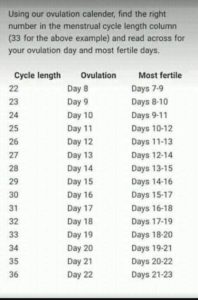Monitoring signs of ovulation is crucial for women trying to conceive. Here are some key indicators:
– Cervical Mucus Changes: Wetter, thinner, more translucent, and slippery mucus indicate ovulation.
– Body Temperature: A slight rise in temperature post-ovulation is observed.
– Mittelschmerz: Lower abdominal pain during ovulation.
– Mood Swings: Increased desire for sexual intercourse.
Ovulation Timing
Determining ovulation day helps in maximizing pregnancy chances. Counting days from the start of menstruation can approximate ovulation:
– Example: For a 28-day cycle, ovulation typically occurs on the 14th day; for a 26-day cycle, it’s around the 12th day.
Pregnancy Duration based on Age
The time to conceive varies based on age:
– Under 25: About 2 to 3 months with regular sex.
– Over 35: Six months or more for conception.
Maximizing Fertility
– Timing: Peak fertility is three days around ovulation.
– Lifestyle Changes: Alcohol reduction, caffeine control, and smoking cessation enhance fertility.
– Optimal Foods: Staples like olive seeds, African cucumbers, honey, nuts, fruits, and vegetables bolster fertility.
Factors Affecting Infertility
– Infections: Bacterial infections can hinder pregnancy.
– Blocked Tubes: Untreated inflammation can lead to blocked Fallopian tubes.
– Lack of Ovulation Awareness: Understanding signs of ovulation is crucial.
– Sperm Issues: Men’s sperm quality greatly impacts fertility.
– Sperm Pouring Back: Abnormalities can cause sperm to flow back after intercourse.
Understanding ovulation, timing intercourse correctly, and maintaining a healthy lifestyle are essential components in maximizing fertility and increasing the chances of pregnancy. Recognizing indicators of ovulation, optimizing lifestyle choices, and addressing potential factors contributing to infertility play critical roles in aiding conception and fostering a conducive environment for pregnancy.
For women seeking to conceive, a comprehensive understanding of ovulation, fertility factors, and potential obstacles to pregnancy is vital. By incorporating lifestyle adjustments, monitoring key ovulation signs, and addressing potential fertility issues, individuals can enhance their prospects of successful conception. If you require more insights or specific information on fertility and reproductive health, do not hesitate to seek further guidance or medical advice.
Additional Information
Ovulation—the magical moment in a woman’s menstrual cycle when an egg is released from the ovary into the fallopian tube, primed and ready for that potential life-altering encounter with sperm. Let’s break it down a bit more scientifically:
What Happens during Ovulation?
– Timing: Ovulation typically occurs around the midpoint of a woman’s menstrual cycle. For a woman with a 28-day cycle, this usually falls around day 14.
– Egg Release: An egg is released from one of the ovaries. If fertilization occurs (sperm meets egg), it can lead to pregnancy.
– Hormonal Shifts: Hormones like estrogen and luteinizing hormone (LH) surge, triggering the egg release.
– Fertility Window: Ovulation signals the most fertile window in a woman’s cycle, lasting around 24 hours, during which conception is most likely.
Signs of Ovulation:
1. Cervical Mucus Changes: Becomes thin, stretchy, and clear, resembling raw egg whites, to facilitate sperm movement.
2. Basal Body Temperature (BBT): A slight increase in BBT after ovulation due to progesterone release.
3. Ovulation Pain (Mittelschmerz): Some women experience lower abdominal discomfort during ovulation.
4. Libido Surge: Increased sex drive around ovulation, possibly due to hormonal fluctuations.
Why Is Ovulation Important?
– Fertility: Ovulation is vital for conception. Timing intercourse around ovulation maximizes the chances of pregnancy.
– Cycle Regularity: Monitoring ovulation helps track cycle regularity and detect any abnormalities.
– Hormonal Balance: Healthy ovulation signifies balanced hormonal function critical for overall reproductive health.
Tracking Ovulation:
There are several methods to track ovulation, such as ovulation predictor kits, basal body temperature charting, and monitoring cervical mucus changes. Understanding your ovulation pattern can aid in family planning, fertility awareness, and identifying any potential reproductive issues.
So, there you have it—ovulation demystified, the pivotal moment in a woman’s cycle that holds the key to fertility and the possibility of creating new life. If you’re delving deeper into fertility matters or aiming to conceive, understanding ovulation is a great starting point on your journey to parenthood!

 Pazionmedia.com Pazion Media l Latest News l Politics l Sports l Entertainment
Pazionmedia.com Pazion Media l Latest News l Politics l Sports l Entertainment



